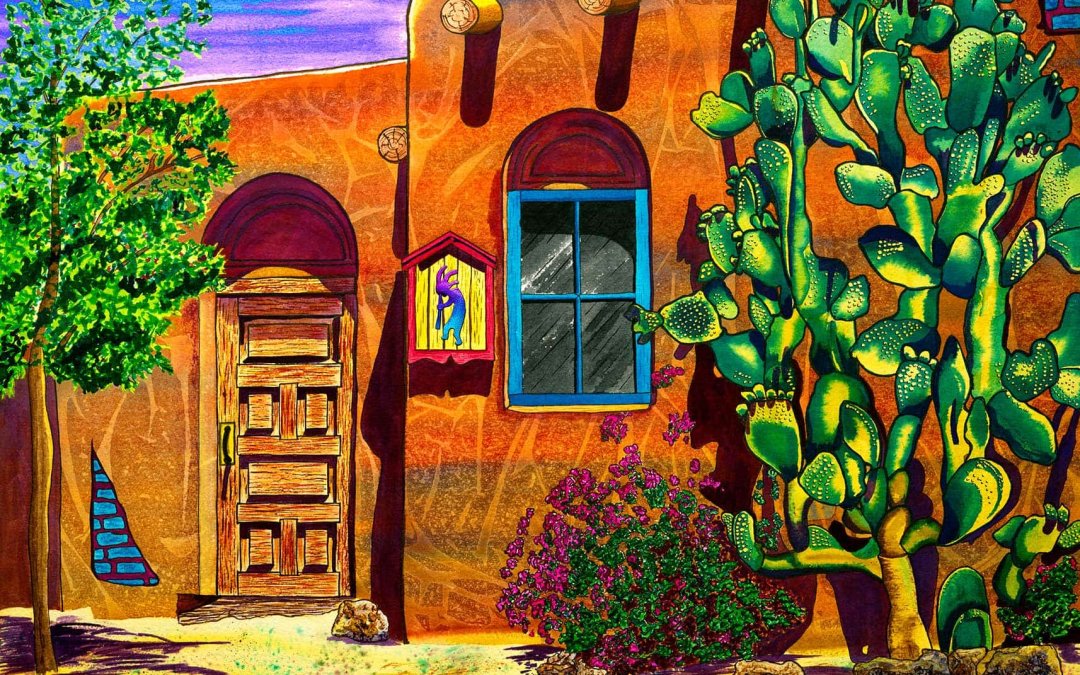Pitiado is as much a portrait of process as it is of place. I painted it in the early 1990s while living in New Jersey, far from Sedona’s iconic red rocks, but my imagination was already drawn to the Southwest. Around that time, I took a workshop with Skip Lawrence that changed my perspective on watercolor. Until then, I treated the surface like a space to control. Skip taught me to see it as a field of discovery.
In Pitiado, I embraced that lesson. I used frisket to reserve highlights, sprinkled kosher salt into wet washes to develop crystalline textures, pressed Saran Wrap against damp pigment to map fractured surfaces, and even used a hairdryer to chase color across the paper. The air pushed pigment into tiny riverbeds and eddies I could never have drawn by hand. Each layer revealed a surprise, a reminder that watercolor thrives when you let go.
To these textures, I added a Kokopelli, the flute-playing figure who has appeared in desert imagery for centuries. For me, a Kokopelli wasn’t just decorative—he was a bridge. Placing him against weathered adobe walls linked my East Coast studio experiments to the spirit of the Southwest. He became a way of honoring that the land has always had its own music, waiting for artists to listen.
Collectors responded strongly to Pitiado. Many told me it felt alive, as if the textures themselves were breathing. The original soon found a home, but the image has remained one of my enduring sellers. Its appeal lies not in polish but in process—the visible record of play, patience, and chance. It showed me that experimentation wasn’t a distraction from art; it was art itself.
Looking back, I see Pitiado as one of the first stepping stones on the path that led me to where I am now. It taught me that a painting could carry both technique and story. It prepared me for later works like Tequila Sunrise, where bold fluorescent acrylics replaced watercolor’s translucence, but the spirit of experimentation remained. It also connects directly to Morgan, my Sedona’s Red Rock Roadrunner, which similarly explores humor, color, and Southwest motifs.
Collectors often display Pitiado in creative spaces—studios, offices, entryways—places where process itself is honored. Reproductions in canvas gallery wraps, luminous metal prints, and giclée art prints preserve their layered textures, making the Southwest spirit portable. While watercolors don’t carry the 3-D black light glow of my fluorescent acrylics, Pitiado emits a quieter glow. It radiates curiosity, discovery, and the timeless song of a Kokopelli.
Within my Top Nine, Pitiado symbolizes beginnings. Pure Joy captures scale. Cathedral Moon marks my first oil. Devil’s Bridge and Coyote’s Lunar Serenade showcase the luminous potential of fluorescent acrylics. But Pitiado remains the early whisper that said: try, play, see what happens. And from that whisper, a body of work grew that still leans on those lessons.
In the end, Pitiado isn’t just about Adobe walls and a Kokopelli’s song. It’s about what happens when you let go of certainty and let art lead you into new territory. It’s about the joy of discovery, the courage of play, and the enduring spirit of the Southwest.
Explore Pitiado and the full Top Nine collection here

